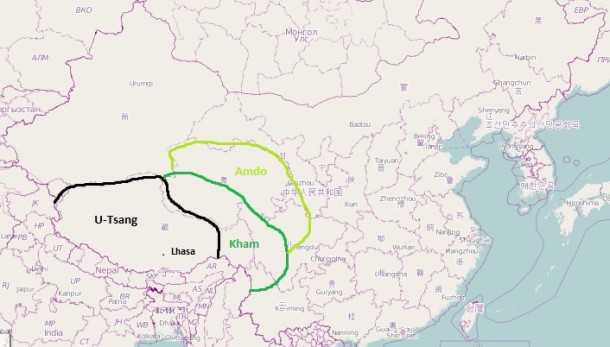Three Great Areas of Tibet
A glimpse into the history tells us that the Tibetan Empire was a dominant power in Central Asia in seventh century during the times of three great kings of Tibet. It consisted of huge territories through unification and expansion of the empire. It was the post-Mongolian invasion of Tibet that the territory of Tibet was divided into three provinces or three great areas as we know today: U-Tsang, Kham and Amdo.

U-Tsang refers to the areas that historically covered western and central Tibet. Popular travel destinations of Tibet like Lhasa, Shigatse, Namtso and Kailash are located in this region. The native people of this area are specially known for their very religious minds. Most of this area now falls under the “Tibetan Autonomous Region”. You need special Tibet Travel Permit document for entering this area.
Kham is the area covering south eastern part of Tibet. The native people of this area are known as Khampas, they are known for their bravery and physical strength. Some western observers think that Khampas were once the finest warriors in the world. In today’s context, area of Kham has been divided in several regions in Sichuan, Yunnan, Qinghai provinces of China, while a chunk of eastern part of Kham comes under “Tibetan Autonomous Region”.
Amdo is the area covering north eastern part of the Tibetan plateau. The native people of this area are called the Amdowas. The typical trait of people in this region is intellectual capacity and hard-working nature. Many of the Tibet’s traditional renowned scholars were of Amdo origin. Today, the area is located midway between Qinghai, Gansu and Sichuan provinces.
Despite the variations in the geographical features of each region, people in all the three great areas of Tibet are bonded together by their strong faith in Buddhism. One can easily find hundreds of historical monasteries and temples or varied sizes in all three regions.
While most of the Tibet-explorers from overseas prefer to visit only several better known parts of the Tibet—with most of them located in U-Tsang, your Tibetan experience will remain incomplete without exploring Kham and Amdo.
Recent Posts
Top Festivals in Tibet During Summer
Discover Tibet in 2024
Traveling to Tibet Alone
All Categories
- About Tibet
- book a Tibet tour
- Buddhism Practice
- Budget Tour
- China-Tibet Train
- Customized Tibet tour
- Historical Sites
- Hot Springs in Tibet
- News
- Photography in Tibet
- Tibet attraction
- Tibet Group Visa
- Tibet Motorcycle Tour
- Tibet Small Group Tours
- Tibet Tours and Tibetan Tour Guide
- Tibet Train
- Tibet Travel FAQs
- Tibet Travel Information
- Tibet Travel News
- Tibet Travel Permit Update
- Tibet Travel Prices Rises
- Tibet Trek
- Tibet Trekking Tour
- Tibet weather and climate
- Tibet Wildlife animals
- Tibet Winter Tour
- Tibetan Buddhism
- Tibetan Cultural Features
- Tibetan Culture and Poeple
- Tibetan Festivals
- What to see in Tibet



